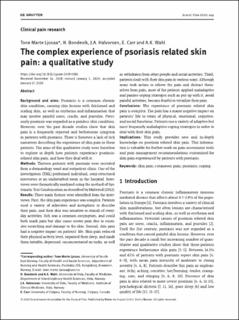| dc.contributor.author | Ljoså, Tone Marte | |
| dc.contributor.author | Bondevik, Hilde | |
| dc.contributor.author | Halvorsen, Jon Anders | |
| dc.contributor.author | Carr, Eloise | |
| dc.contributor.author | Wahl, Astrid Klopstad | |
| dc.date.accessioned | 2020-11-03T13:36:30Z | |
| dc.date.available | 2020-11-03T13:36:30Z | |
| dc.date.created | 2020-01-21T15:07:11Z | |
| dc.date.issued | 2020 | |
| dc.identifier.citation | Ljosaa, T. M., Bondevik, H., Halvorsen, J. A., Carr, E., & Wahl, A. K. (2020). The complex experience of psoriasis related skin pain: a qualitative study. Scandinavian journal of pain, 20(3), 491-498. | en_US |
| dc.identifier.issn | 1877-8860 | |
| dc.identifier.uri | https://hdl.handle.net/11250/2686235 | |
| dc.description.abstract | Background and aims: Psoriasis is a common chronic skin condition, causing skin lesions with thickened and scaling skin, as well as erythema and inflammation that may involve painful sores, cracks, and pustules. Previously psoriasis was regarded as a painless skin condition. However, over the past decade studies show that skin pain is a frequently reported and bothersome symptom in patients with psoriasis. There is however a lack of rich narratives describing the experience of skin pain in these patients. The aims of this qualitative study were therefore to explore in depth how patients experience psoriasis-related skin pain, and how they deal with it.
Methods: Thirteen patients with psoriasis were recruited from a dermatology ward and outpatient clinic. One of the investigators (TML) performed individual, semi-structured interviews at an undisturbed room in the hospital. Interviews were thematically analyzed using the method of Systematic Text Condensation as described by Malterud (2012).
Results: Three main themes were identified from the interviews. First, the skin pain experience was complex. Patients used a variety of adjectives and metaphors to describe their pain, and their skin was sensitive to stimuli of every-day activities. Itch was a common cosymptom, and could both mask pain but also cause severe pain due to excessive scratching and damage to the skin. Second, skin pain had a negative impact on patients’ life. Skin pain reduced their physical activity level, impaired their sleep, and made them irritable, depressed, unconcentrated on tasks, as well as withdrawn from other people and social activities. Third, patients dealt with their skin pain in various ways. Although some took action to relieve the pain and distract themselves from pain, most of the patients applied maladaptive and passive coping strategies such as put up with it, avoid painful activities, become fearful or trivialize their pain.
Conclusions: The experience of psoriasis related skin pain is complex. The pain has a major negative impact on patients’ life in terms of physical, emotional, cognitive, and social functions. Patients use a variety of adaptive but most frequently maladaptive coping strategies in order to deal with their skin pain.
Implications: This study provides new and in-depth knowledge on psoriasis related skin pain. This information is valuable for further work on pain assessment tools and pain management recommendations customized for skin pain experienced by patients with psoriasis. | en_US |
| dc.language.iso | eng | en_US |
| dc.title | The Complex Experience of Psoriasis Related Skin Pain: A Qualitative Study | en_US |
| dc.type | Peer reviewed | en_US |
| dc.type | Journal article | en_US |
| dc.description.version | publishedVersion | en_US |
| dc.rights.holder | © 2020 Scandinavian Association for the Study of Pain. Published by Walter de Gruyter GmbH, Berlin/Boston. All rights reserved. | en_US |
| dc.source.pagenumber | 491-498 | en_US |
| dc.source.volume | 20 | en_US |
| dc.source.journal | Scandinavian Journal of Pain | en_US |
| dc.source.issue | 3 | en_US |
| dc.identifier.doi | https://doi.org/10.1515/sjpain-2019-0158 | |
| dc.identifier.cristin | 1779352 | |
| cristin.ispublished | true | |
| cristin.fulltext | original | |
| cristin.qualitycode | 1 | |
